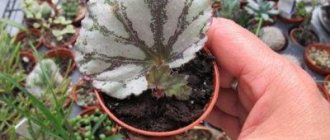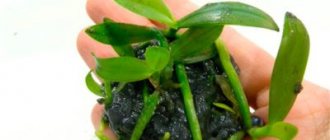Coleus flower, what’s wrong with the name of this amazing semi-shrub plant and why is propagation of coleus by cuttings considered the most effective and correct?
How to care for your unpretentious pet so that it can delight you with its extraordinary beauty as an annual or perennial plant?
The answers to these questions, as well as a description of the process of propagating my coleus by cuttings, followed by “care” for young plants without any experiments and the result obtained with an analysis of the mistakes I made - you will find all this by reading this publication to the end.
Coleus - my introduction to the flower
Coleus in a pot
My acquaintance with coleus, one might say, happened completely by accident, in June 2022, and until that moment I did not even suspect their existence. One day at the beginning of June, while visiting good friends, there was a conversation about landscaping a street gazebo; At that time, this question was very relevant for our family, since we were looking for suitable plants just for ours.
The problem was that due to the location of the gazebo itself, not all the plants that we would like to plant around it were suitable for these purposes: for example, there was not enough light for cultivated grapes, but for hostas, on the contrary, it was sunny, etc. P.
But as they say: “One head is good, but two are better.” So, in the process of lively communication, we were offered, as an option, to plant plants not outside the gazebo, but inside it, in flower pots. And they not only advised, but also provided us with coleus seedlings, which they grew from the seeds of this “flower.”
From their words, it turned out that coleus is an ideal flower in our case, since it is unpretentious, grows quickly, reproduces easily, just likes shading from direct sunlight and, in general, is a source of aesthetic pleasure.
But as it turned out later, coleus, however, like all ornamental plants, also requires proper care. In addition, coleus can hardly be called a flower in the usual sense, rather an annual or perennial flowering semi-shrub plant, since it is valued solely for the unusual shape and beauty of its leaves, and not for its elongated, candle-shaped, spike-shaped inflorescences with small and not very attractive flowers , although not without a subtle aroma.
Description of the plant
Coleus
Coleus is the Latin name for the plant. People simply call it nettle, since the flower in its natural environment is a bit like nettle, but with bright leaves. Belongs to the genus of evergreen, perennial plants from the Lamiaceae family. Its homeland is considered to be Africa and Asia. The flowers are inconspicuous and simple, but they smell nice.
Interesting!
On the island of Java, coleus is planted along the edges of coffee plantations to protect the plantings from wild boars.
The height of the crop can be different and depends on the type, variety, and place of growth. It has a strong stem, which is usually woody at the base. Leaves are the main quality of a plant. They are heart-shaped, jagged at the edges. They are the most decorative, aesthetic part of culture. The color of the leaves can be very diverse: burgundy, purple, red, yellow, brown, green, with spots or stripes. There can be one or two colors, sometimes more.
Coleus planting and care
There were no problems at all with planting the donated coleus in a large flower pot: we simply carefully transferred them along with the soil from the cups in which they took root to a new place, having previously mixed a five-centimeter layer of crushed stone of fine and medium fractions onto the bottom of the pot to create a drainage layer and, adding a little soil to the pot, but not from the garden, but brought from the planting.
They watered the soil well with warm, settled water and placed the gazebo on the sunny side to grow.
We did not take any special actions to care for the fast-growing coleus; they just keep growing and growing. The main thing is not to allow the soil to dry out at any time, as it was the case that if you didn’t water for a day, the leaves immediately drooped - it’s still a waste of water.
But you shouldn’t overwater it, otherwise the roots may rot and the plant will die.
For irrigation, we used warm water, either rain or settled water; you understand that tap water is hard, and plants, not just coleus, react very painfully to such water.
As for lighting, coleus loves light very much, but moderation is needed here too, the leaves are very delicate and when exposed to direct sunlight they get burned and get sick, unfortunately our coleus, due to my oversight and ignorance, did not escape this fate.
But, however, I will separately discuss my mistakes in caring for coleus plants below, in one of the subsequent chapters. “But they do exist,” as they say in Odessa.
Watering
Coleus soil should always be moderately moist. In summer, water often and abundantly (while not allowing water to stagnate), in winter - less often, but without allowing the soil to dry out.
Watering is carried out only with warm, well-settled water so that moisture does not fall on the leaves.
To brighten the leaves, the water can be slightly acidified with lemon juice - 4-5 drops per glass (200 ml) of water or hydrogen peroxide - 20 ml per 1 liter of water.
Coleus propagation
As I mentioned earlier, the coleus given to us were grown from seeds in purchased universal soil for seedlings, in an ordinary shallow plastic container under film and then, when sprouts with several leaves began to appear, they were planted (picked) one at a time into small, 100 ml, plastic cups for rooting, in which holes were made at the bottom using a nail heated until red to drain excess water.
But, again, according to our friends, some of the seeds did not germinate and some of the seedlings did not take root in the cups due to damage to the roots during transplantation and, accordingly, also died.
Therefore, they advised us to propagate coleus by cuttings and drew attention to the fact that they did not succeed at all when trying to propagate coleus with leaves, thereby discouraging us from any desire for such experiments.
Propagation of coleus by cuttings
Coleus cuttings
After twenty days, our coleus grew so much in the new place and stretched upward by about 30 cm that, in my opinion, they became suitable for propagation by cuttings. Unfortunately, at that moment, no one told us how to do it correctly, and we ourselves somehow didn’t even think to “Google” this question. And therefore, when cutting cuttings and planting them in the ground, we also made several mistakes, which later, looking ahead, I will say, led to the drying out of one of them.
Coleus cuttings and planting in the ground
Coleus cuttings and planting in a pot
So, by June 27, 2022, we had five coleus grown and we decided to propagate them all by cuttings directly into the ground. At first they thought of rooting coleus cuttings in water, as our friends who gave us coleus did, but, in their opinion, there is a high probability that when planting in the ground, the underdeveloped water roots may simply break off. Therefore, we decided to immediately plant the resulting cuttings in a pot with soil and let them take root there and grow to our delight.
The stems of young coleus are quite soft and it was enough to force the nail of the thumb of the right hand to pinch the crown and get a cutting, pos. 1
, or use for these purposes a disinfected sharp knife, blade or medical scalpel, which can be purchased at a pharmacy; Here it costs from seventeen rubles apiece.
So that the cuttings, God forbid, do not dry out while the essence is still important, place them in a plastic bucket with warm, settled water, pos. 1
. Although some, on the contrary, recommend slightly drying the cuttings in the shade in the air before planting, to speed up root formation after planting them in the ground.
Write in the comments, how do you do it?
Then, from the same bucket, I spilled the soil well in a flower pot, pos. 2
and began to prepare the cuttings themselves for planting them in the ground.
To do this, in each cutting, again with a fingernail, I plucked off the bottom two leaves, positions 3, 4, 5
and
7.
And only then each cutting was stuck into the soil spilled with warm water, almost under the very bottom leaf of each cutting,
positions 6 and 8
, first Using a pencil, make indentations in the soil for easy planting of cuttings.
Coleus growing in a flower pot
And, in fact, that’s all, after planting all the cuttings, and there were already seven of them, all that remained was to wait for a positive result in the form of the growth of new greenery on the rooted cuttings.
Rooting coleus cuttings
Rooting cuttings
What can we say, coleus takes root really quickly, from the moment all the cuttings are planted in the ground, pos. 9
, some 15 days have passed and not only an increase in leaf size in rooting cuttings has already become clearly noticeable, but also an increase in their growth,
pos. 10
.
These changes became even more striking after 23 days, on the twentieth of July, pos. 11.
Without any doubt, all the cuttings clearly felt very good, since a significant increase in growth was evident, and it was simply impossible to believe that this was possible without roots.
Of the seven cuttings planted for rooting, six clearly showed activity in their growth, but one, the very first one, positions 3, 4, 5, 6
; from the very beginning I began to lag far behind and with each new day this lag became more and more significant.
He was either clearly ill or felt uncomfortable in this motley campaign. In the end, on the thirty-sixth day of his unsuccessful attempts to somehow begin to grow, I saved him from this torment by pulling him out of the ground. Oddly enough, he had roots, but he didn’t grow, so that’s what happens.
Below in the “mistakes” I will return to it again.
Rooting coleus
For this reason, the remaining and rooted coleus continued to amaze with the dynamics of its growth, pos. 12
inflorescences began to form on one of them,
position 13
Caring for cuttings during rooting
Coleus
Here I will not discover America if I say that both rooting cuttings and growing coleus, especially in summer, need daily watering with warm, settled water, in order to avoid unwanted drying out of the soil.
However, under no circumstances should you overwater the plants, since excess soil moisture will lead to rotting of the roots with a corresponding sad outcome. Therefore, when it rains, it is advisable to remove or move pots with coleus plants out of the rain.
In order for coleus to actively grow, develop and take root, it is necessary to have a sufficient amount of both sunlight and sufficient humidity and heat from the surrounding air, from +25ºС.
At temperatures below +12ºС, the development and growth of coleus slows down greatly, and if the air is relatively dry, it would not be a bad idea to spray around the flower with a spray bottle.
During the period of rooting coleus cuttings, I did not use any fertilizers or any organic fertilizers and, as my practice has shown, coleus cuttings take root in the soil well without them.
The main mistake when rooting coleus cuttings
Coleus cuttings for propagation
Unfortunately, I was unable to avoid mistakes when rooting my coleus. And the most important thing, perhaps, lies in cutting a cutting from a branch with unformed leaves, and therefore the leaf on it turned out to be weak and small, pos. 1
.
Actually, that’s why, I think so, this cutting, unable to compete with other, more developed cuttings, position 2
, stopped growing and, as a result, began to wither and was removed from the flower pot.
Mistakes when caring for coleus
Coleus - improper care
Despite the seemingly unpretentiousness of coleus, a number of mistakes that I could not avoid due to ignorance when caring for this flowering plant significantly affected both its appearance and its physical condition (leaf turgor).
Turgor in plants is the healthy, normal state of the leaf: it has a bright color, elastic and dense to the touch.
Later, after looking through various information, sometimes even contradictory, on caring for coleus, I identified my most basic mistakes, which I would like to focus on so as not to repeat them again and again in the future:
- Sometimes he allowed the top layer of soil in pots with plants planted in them to dry out, causing their leaves to droop and them to look depressed;
- It was not always possible to shade the coleus plants from direct sunlight in time and, as a result, burns occurred on some leaves, and discoloration of the leaves appeared on one of the plants, pos. 1
; - I did not pinch the stem in a timely manner, which caused the stem to grow without the formation of side shoots with new leaves, pos. 2
; - I did not ensure that a sufficient amount of light was supplied to the coleus, which affected the deterioration of the brightness of the color of the leaves, pos. 3
; - I did not remove the frequently appearing peduncles, which greatly depress the plant and prevent the leaves from growing larger, pos. 1
; - I did not regularly feed the coleus plants with potassium fertilizers, which affect leaf growth;
- I didn’t do the pruning and early formation of the bush on time, which is why the plant now looks unkempt, pos. 1
.
When and how to take coleus cuttings
In fact, you can cut coleus throughout the year, but, naturally, in spring and summer this percentage is much higher for objective reasons (longer daylight hours, more comfortable air temperature).
Cuttings for rooting are cut only from the tops of healthy shoots that have at least two fully formed leaves.
The length of the cutting, preferably, should not be less than 10 cm, and a cut on a young plant can be easily made with a pre-disinfected sharp knife, blade or scalpel. Scissors are not suitable for these purposes, as when cutting they crumple and deform the plant stem.
If cuttings are taken in winter from coleus growing in a room, then additional artificial lighting is necessary for their rooting.
Rest period
In winter, coleus enters a dormant period - its growth slows down.
The plant is prepared for the dormant period by gradually stopping feeding and reducing watering. It is advisable to keep the coleus at a cooler temperature during this time - +15o - +16o. At the same time, do not limit the light and maintain a high level of humidity. You need to water just enough so that the soil does not dry out.
Drastic pruning of coleus is carried out at the beginning of the growing season, cutting off all shoots up to 10 cm. Cuttings are rooted for propagation. They can be replanted with an old plant for greater bush density or planted in open ground with the onset of warm weather.
Coleus of different varieties
Propagation is carried out by seeds and cuttings. Both methods are simple and successful.
Pruning and proper formation of coleus
Coleus internode
It must be borne in mind that pruning and pinching of coleus plants for a beautiful and correct formation of the bush is recommended to begin immediately, at an early stage of development (growth), as soon as the plant reaches three internodes in its growth. As a rule, young plants easily respond to such pruning, unlike adults. In the future, as the coleus grows and develops, it is necessary to regularly pinch its tops and trim off the shoots growing inwards.
Complete pruning of domestic perennial coleus growing in the house, for its rejuvenation, should be done in February or March to the height of one stem space (internodes) from the ground, however, the plant can also be transplanted along with the soil into a larger pot, but As coleus experts note, it should not be kept for more than three years, even taking into account complete pruning and replanting, but cutting cuttings from the mother plant and then growing them to replace them is what is called the very thing.
Air humidity
Air humidity is maintained quite high. The air around the coleus is regularly sprayed , trying not to get on the foliage (water can leave stains on the leaves). Water containers located next to the plant also increase air humidity well.
You can place the pot with the plant on a tray with moistened pebbles or expanded clay. The bottom of the pot should not come into contact with water, so that the roots do not become waterlogged.
Coleus-Kong-Rose
What causes coleus and its pests?
Coleus is a fairly hardy plant that is resistant to various diseases and pests, but it can also get sick if not cared for properly: leaves droop, lose color, internodes stretch out or roots rot, but, as a rule, correcting the situation with watering, lighting, proper and timely fertilizing with nitrogen and potassium fertilizers, you can restore the plant’s former healthy appearance and its turgor, since it quickly adapts to new conditions.
Aphids, whiteflies, spider mites: pests for coleus
It is much worse if coleus is chosen as its habitat by pests such as:
- aphid, rice 1
; - whitefly, rice 2
; - spider mite, Fig. 3
.
If you don’t pay attention to the appearance of these “parasites” in time, you can soon say goodbye to your flowers - this is no joke.
Therefore, first of all, it is necessary to pay attention to any external changes in our plants, this applies not only to coleus, but to all others.
If you bought a new flower, don’t put it on the windowsill with the others at first, watch it, if these pests don’t show themselves in any way within ten days, then the plant is healthy and there’s no need to worry.
Aktara, Konfidor: insecticides for coleus
But if cobwebs appear on the leaves or punctures from larvae and mites can be seen on the leaf, then you need to sound the alarm and stock up on Aktara, Fig. 1
or “Confidor”,
Fig. 2 and 3
, since you will have to treat your plants with these chemicals more than once.
What products do you use to control pests? Please write about this in the comments to this post.











